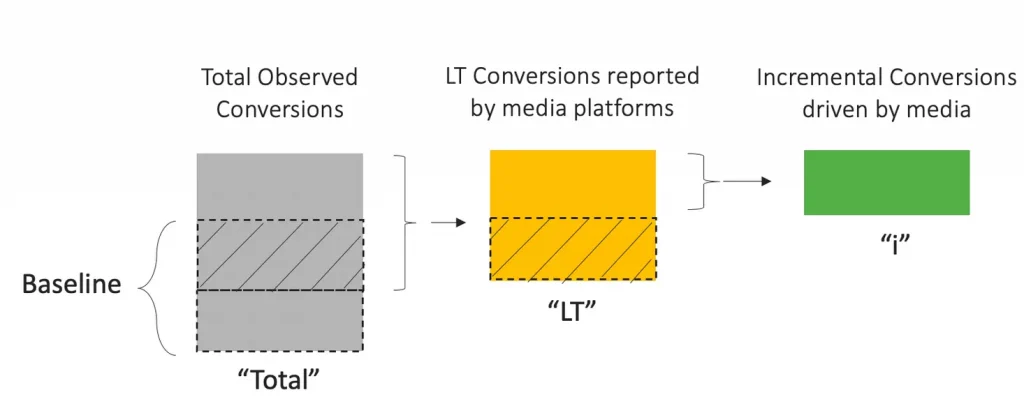The goal of cross-platform or cross-channel attribution is to gain visibility into performance across the entire media mix and reveal how each marketing channel, tactic, or campaign contributes to conversions and sales.
What are the best cross-channel attribution Methods?
Common methods for cross-channel attribution include multi-touch attribution (MTA), media mix modelling (MMM), and incrementality measurement.
Multi-touch Attribution collects individual, user-level data for addressable (trackable) media and conversion events to determine the impact each media event has on a customer’s path to conversion. Because MTA requires tracking and connecting all media at the user level, it does not account for non-addressable media, like print, radio, and traditional (linear) TV, which cannot be tracked to individuals.
What is multi-touch attribution?
Multi-touch attribution is a marketing effectiveness measurement technique that takes all of the touchpoints on the consumer journey into consideration and assigns fractional credit to each so that a marketer can see how much influence each channel has on a sale.
Multi-touch attribution offers a more sophisticated alternative to traditional, rules-based attribution approaches, such as first- and last-touch, which give all of the credit to the first or last marketing touchpoint before the consumer converts through a purchase, download or any other event.
Media mix modelling collects aggregated data from marketing and non-marketing sources over a multi-year historical period, also factoring in external influences such as seasonality, economic data, weather, and promotions. The data is then used to develop a demand model which quantifies the historical contribution of each marketing and non-marketing input to a business outcome, like sales or conversions.
What is Marketing/Media Mix Modeling (MMM)?
Marketing Mix Modeling (MMM) predicts business outcomes through a statistical analysis using multivariate regressions, with marketing tactics and spending as variables. The regressions provide contributions of each variable to outcomes, which are then used to predict what conversions and sales would be with different inputs or marketing mixes.
Using MTA and MMM for cross-channel attribution has proven to be difficult for reasons including:
- Many platforms like Amazon and Facebook are walled gardens and inaccessible to third-party tracking of impressions.
- Identity resolution across media platforms is quite low.
- Cross-device tracking is difficult and match rates are extremely low.
- Instrumenting a tracking infrastructure by a third-party measurement provider has proved to be fraught with breakage and data leakage.
- Both are extremely time-consuming to implement and maintain and require experience in data science and analytics.

Incrementality testing is an alternative approach to cross-channel attribution that isn’t plagued by all the issues above. Deployed within the publisher platforms themselves, incrementality experiments provide marketers with a true understanding of the incremental contribution of each marketing channel down to the most granular level.
What is Incrementality Testing?
Incrementality testing creates an experiment that systematically withholds media channel exposure to a representative subset of users (the control group) while maintaining normal media channel exposure to the broader user set (the test group).
If the control group is both sizable enough to be statistically significant and selected at random such that they are broadly representative of the user base, then the media channel’s incremental contribution can be determined by the difference in business outcome (conversion, revenue, profitability, etc.) between the test and control groups.
Incrementality testing is sometimes referred to as Incremental Sales Lift, Uplift Modeling, or A/B testing.
Difference between Incrementality and Lift
- “Incrementality” indicates the portion of last-touch conversions that were truly driven by that Media.
- “Lift” indicates the increase in the overall business that these incremental conversions represent.

What is Multi-Touch Attribution (MTA)?
Multi-touch attribution (MTA) collects individual, user-level data for addressable (trackable) media and conversion events to determine the impact each media event has on a customer’s path to conversion. Because MTA requires tracking and connecting all media at the user level, it does not account for non-addressable media, like print, radio, and traditional (linear) TV, which cannot be tracked to individuals.
Implementing an effective multi-touch attribution model is a complex and difficult process, but can deliver results far superior to first or last-click reporting, especially if the media mix is largely made up of addressable media.
How is multi-touch attribution implemented?
User-level tracking is typically performed using Google Analytics, tools from data tracking vendors, or one of the many open-source tracking pixels available. Theoretically, the tracking data is then used to create detailed user click paths that map out the media touchpoints a customer encountered leading up to a conversion.
Uncover what’s working in your digital media strategy
With the flexibility and customisation that digital marketing offers, traditional measurement methods have to evolve. Setting up the right data inputs in your marketing mix model at the outset of your campaigns means more powerful, actionable measurements in the output. Ensure you evaluate your campaigns at the right level of granularity to get the most out of your modelling — and your media investment.
You may also enjoy this article on Sustaining Email Attribution Models for ecommerce





